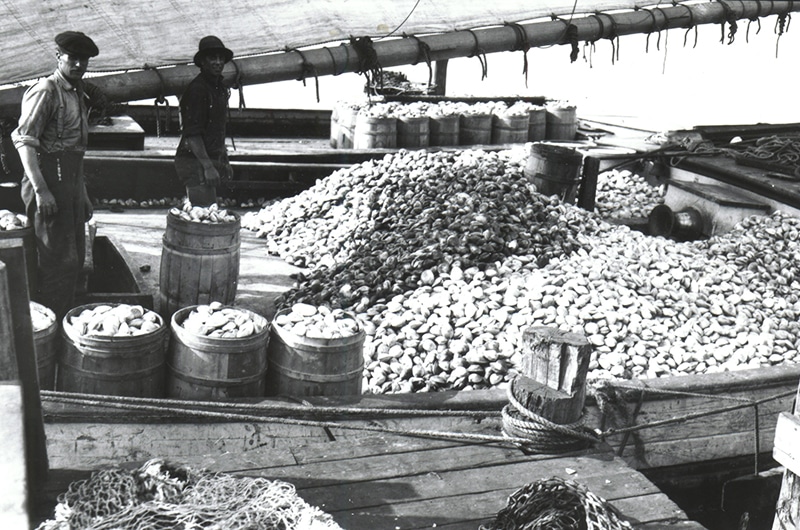~ by Amy Jenness ~

In 1913 an Edgartown fisherman named Sam Jackson was dragging for flounder around Tuckernuck Shoal when he discovered a massive bed of quahogs and forever changed the island’s shellfish industry.
For centuries local fishermen had harvested large clams, also known as quahogs, as well as oysters and scallops. Prior to Jackson’s discovery, quahog fishermen rowed their dories into Nantucket and Madaket harbors and gathered the shellfish in shallow water using large tongs. A typical catch was three to four bushels a day. For 1912, industry analysts guessed that the Nantucket quahog industry brought in about $100,000.
In June of that year the Inquirer & Mirror noted, “Fifty-eight boats were at work on the quahog beds in the harbor Wednesday morning. And with this little gold mine right in the harbor, within a mile or so from town, the Nantucket fishermen have been foolish enough to permit thousands of bushels of seed quahogs to be shipped to other places to grow and become a source of revenue!” That year fishermen were upset that thousands of quahog seed had been shipped to other tows to fortify clam beds there. But that controversy shifted to surprise in 1913 at the thousands of barrels of quahogs lining Steamboat Wharf, brought in by off-island boats daily who paid the steamship to take their catch to the mainland and on to New York City by train.
Word of a huge cache of quahogs—estimated to be ten miles long and four miles wide—just north of Nantucket spread quickly among fishermen, and soon boats equipped with dredging machinery came to drag for quahogs from ports in Massachusetts, Rhode Island, Connecticut, and New York. Local fishermen were not able to harvest quahogs in 40 feet of water. Locals watched as the steamship company profited and a fishing boom developed just north of the island.
In 1914 the New Bedford Standard Times, after speaking with Nantucket residents, aimed to clarify an earlier report that islanders were getting rich off quahogs: Some of the experts claim it (the Tuckernuck Shoals quahog supply) is inexhaustible— if so, the Nantucket quahoggers, the men who have for years eked out their living with a dory and rake from the beds inside the harbor and at Muskeget, are simply facing the termination of “harbor digging…Competition with these boats was out of the question, and the island fishermen, who for years had tilled the heavy quahog rakes, were simply dazed. Their business was gone.
The slow, gentle custom of harvesting shellfish from a dory In the harbor had been replaced by the strength and speed of engines hauling heavy fishing equipment. Steam-powered dredges pulled up quahogs at such a furious rate that their suppliers and transportation companies struggled to keep up. In June of 1914 the Inquirer & Mirror noted, “The quahog fishermen of Nantucket last week ran out of barrels with which to ship their shellfish to New York. On Friday, two automobile loads of barrels were unloaded at the steamboat wharf in New Bedford to be shipped to Nantucket. The barrels were originally made for the cranberry growers on the Cape.”
The fishing boom extended well into the 1920s and in 1916 the Inquirer & Mirror reported:
The extent of that immense bed of shellfish is not known today, any more than it was three years ago. When the fishermen apparently “clean out” one section with repeated digging day after day and month after month, they find the quahaugs “farther out” or “farther in” or to the eastward or westward, as the case may be, some of the boats when at work on the beds being miles apart. It is estimated that at least a million and a half bushels of the shellfish have been taken from the beds. After 13 years of watching the local commercial quahog business decline, the immense offshore haul of quahogs by mainland boats and diminishing scallop populations in Nantucket waters, state and local leaders were to over haul regulations on the shellfish industry. In November of 1928 members of a special Shellfish Commission charged with creating a report came to Nantucket to speak with local fishermen.
Captain E. Z. Ryder spoke for the locals. “It is my opinion that Nantucket would like to have the laws drawn as drastic as possible, but the control should rest in local authorities. When I moved here from the Cape 18 years ago there were plenty of scallops everywhere, but there has been a gradual decrease from year to year. The same thing is true of quahogs. There are very few littlenecks now. If we keep taking away and don’t add we will soon find the industry gone,” the Inquirer & Mirror reported.
The state had implemented rules and catch limits on quahogs for many years, but the 1928 committee recommended stricter regulations and improved oversight. Soon, with consent of the state, the town began to distribute scallop and quahog seed, set boundaries for how close commercial boats could fish to the island and restrict the amount of shellfish that could be taken in local waters.
Once considered limitless, the Tuckernuck Shoal quahog bed was largely depleted by 1930. No one knows exactly how many quahogs were harvested there since many boats took their catch directly to a mainland port. Boats had once taken hundreds of barrels, but in 1929 the Inquirer & Mirror noted, “Quahogs are still being harvested from the beds in the sound, not far from Tuckernuck Shoal. The Beatrice B. brought in 14 barrels Monday afternoon, after a few hours’ dredging.” Amy Jenness is the author of On This Day In Nantucket History.